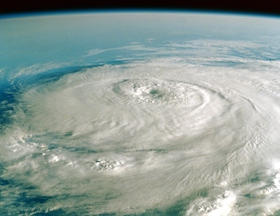The WPJ
THE WORLD PROPERTY JOURNALReal Estate Facts Not Fiction
Residential Real Estate News

U.S. Property Markets Experienced Over $60 Billion in Natural Disaster Damage in 2012
Residential News » North America Residential News Edition | By Michael Gerrity | January 8, 2013 8:00 AM ET
 According to CoreLogic's annual Natural Hazard Risk Summary and Analysis report, natural disasters that struck the United States in 2012 had a significant economic impact on property losses nationwide.
According to CoreLogic's annual Natural Hazard Risk Summary and Analysis report, natural disasters that struck the United States in 2012 had a significant economic impact on property losses nationwide."Hurricane Sandy was, without a doubt, the single most destructive natural hazard event of 2012, due to the combination of environmental elements that created what the National Oceanic and Atmospheric Association (NOAA) called a 'Frankenstorm,'" said Dr. Thomas Jeffery, senior hazard scientist for CoreLogic.
"The unusually broad span of the storm's reach, its intersecting path with a nor'easter and its landfall at high tide led to disastrous levels of storm surge, pushing flood waters far overland and causing widespread destruction along the coast that could total as high as $50 billion."
Among key findings of CoreLogic 2012 Natural Hazard Risk Summary and Analysis include:
Hurricane
- The single most destructive natural disaster in 2012 was Hurricane Sandy. In late October, the Category 1 storm generated record levels of storm surge along the northern New Jersey coast and in the New York City area, impacting more than 5 million residents across the region.
- The first hurricane to make landfall in the U.S. in 2012 was Category 1 Hurricane Isaac in late August, which caused an estimated $2 billion in insured losses around the New Orleans metro area.
Flood
- Flood losses are expected to total approximately $10 billion in 2012, which would result in the third consecutive year of increasing flood damage in the U.S.
- Prior to Hurricane Sandy, flood events in 2012 were relatively insignificant, with most of them occurring below the Federal Emergency Management Agency 100-year flood levels. In fact, freshwater flood activity through October indicated a decline in flood losses from 2011, on par with CoreLogic historical trend analysis. The broad scope and extreme conditions of Sandy, however, led to widespread flooding along the Atlantic Coast and a significant increase in estimated flood losses for the year.
- Earlier in the year, Tropical Storm Debby tracked slowly across the Florida peninsula in June, dropping at least 25 inches of rainfall along its path.
- After months of sustained, widespread drought, Hurricane Isaac brought heavy rainfall and flooding to Louisiana in late August before continuing northward into the Midwest.
Wildfire
- The 2012 wildfire season was the third most destructive on record in the U.S. in terms of total acres burned as of early December.
- The 15-year trend of fewer, but larger fires continued into 2012 with fewer than 51,000 individual wildfires across the country--the lowest number recorded since 1989.
- Several of the individual fires that occurred in 2012 set records, including Colorado's Waldo Canyon Fire, which damaged or destroyed 346 homes, and New Mexico's Whitewater-Baldy Fire, which burned more than 297,000 acres.
- The rebound in wildfires that occurred in California was not unexpected given that by the end of August approximately 63 percent of the U.S. was experiencing drought conditions as classified by NOAA and demonstrates the cyclical nature of wildfire activity.
- NOAA continues to predict a pattern of drought conditions through the start of 2013, suggesting the potential for another increase in wildfire risk across much of the country.
Tornado
- Tornado activity in 2012 was not strictly limited to the region commonly referred to as "Tornado Alley." States located outside the central and southern Great Plains experienced a significant number of tornadoes this year.
- January 2012 was one of the most active Januaries since recording began in 1950, with a total of 79 tornadoes reported across the country.
- In late February, tornadoes struck Illinois, Indiana, Kentucky and Ohio. Harrisburg, Ill., experienced the most concentrated destruction, with more than 225 homes and businesses damaged or destroyed and an estimated $475 million in total damage.
"Because the strength, severity and geographic impact of natural disaster events will change from year to year, an understanding of patterns in hazard activity, geographic vulnerabilities and the properties exposed to each different type of disaster is crucial to managing risk," said Jeffery.
The report provides an analysis of the impact of hurricane, flood, wildfire and tornado events over the course of the year, as well as a summary of potential risk from natural hazards in 2013. Compiled by CoreLogic spatial science experts, the report summarizes the structural, geographic and financial impact of natural disasters that caused billions of dollars in property damage across the U.S. over the course of the year.
Sign Up Free | The WPJ Weekly Newsletter
Relevant real estate news.
Actionable market intelligence.
Right to your inbox every week.
Real Estate Listings Showcase
Related News Stories
Residential Real Estate Headlines
- More Americans Opting for Renting Over Homeownership in 2024
- BLOCKTITLE Global Property Tokenization Platform Announced
- Small Investors Quietly Reshaping the U.S. Housing Market in Late 2024
- Greater Miami Overall Residential Sales Dip 9 Percent in November
- U.S. Home Sales Enjoy Largest Annual Increase in 3 Years Post Presidential Election
- U.S. Housing Industry Reacts to the Federal Reserve's Late 2024 Rate Cut
- U.S. Home Builders Express Optimism for 2025
- Older Americans More Likely to Buy Disaster-Prone Homes
- NAR's 10 Top U.S. Housing Markets for 2025 Revealed
- U.S. Mortgage Delinquencies Continue to Rise in September
- U.S. Mortgage Rates Tick Down in Early December
- Post Trump Election, U.S. Homebuyer Sentiment Hits 3-Year High in November
- Global Listings Aims to Become the Future 'Amazon of Real Estate' Shopping Platform
- Greater Las Vegas Home Sales Jump 15 Percent in November
- Ultra Luxury Home Sales Globally Experience Slowdown in Q3
- World Property Exchange Announces Development Plan
- Hong Kong Housing Market to Reach Equilibrium in Late 2025
- Construction Job Openings in U.S. Down 40 Percent Annually in October
- U.S. Mortgage Applications Increase in Late October
- World Property Markets, World Property Media to Commence Industry Joint-Venture Funding Rounds in 2025
- New Home Sales Hit 2 Year Low in America
- U.S. Pending Home Sales Increase for Third Consecutive Month in October
- Pandemic-led Residential Rent Boom is Now Fizzling in the U.S.
- Emerging Global Real Estate Streamer WPC TV Expands Video Programming Lineup
- 1 in 5 Renters in America Entire Paycheck Used to Pay Monthly Rent in 2024
- U.S. Home Sales Jump 3.4 Percent in October
- Home Buyers Negotiation Power Grows Amid Cooling U.S. Market
- Canadian Home Sales Surge in October, Reaching a Two-Year High
- Greater Orlando Area Home Sales Continue to Slide in October
- U.S. Mortgage Credit Availability Increased in October
- U.S. Mortgage Rates Remain Stubbornly High Post Election, Rate Cuts
- Construction Input Prices Continue to Rise in October
- BETTER MLS: A New Agent and Broker Owned National Listings Platform Announced
- Home Prices Rise in 87 Percent of U.S. Metros in Q3
- Caribbean Islands Enjoying a New Era of Luxury Property Developments
- The World's First 'Global Listings Service' Announced
- Agent Commission Rates Continue to Slip Post NAR Settlement
- Market Share of First Time Home Buyers Hit Historic Low in U.S.
- Greater Palm Beach Area Residential Sales Drop 20 Percent Annually in September
- Mortgage Applications in U.S. Dip in Late October
Reader Poll
Marketplace Links
This website uses cookies to improve user experience. By using our website you consent in accordance with our Cookie Policy. Read More





